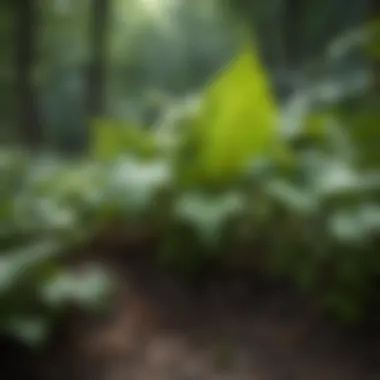Understanding Rhus Toxicodendron: Characteristics & Uses


Intro
Rhus toxicodendron, commonly referred to as poison ivy, presents a unique blend of biological intrigue and practical considerations. While many know this plant for its notorious ability to cause skin reactions upon contact, its characteristics and potential uses extend far beyond mere annoyance. Understanding this plant requires a closer examination of its biology, chemical properties, and roles in both natural ecosystems and traditional practices. This article sets out to dive into these facets, painting a comprehensive picture of Rhus toxicodendron, from its classification to its safety profile.
Research Overview
Methodological Approaches
Research into Rhus toxicodendron employs various methodologies ranging from field studies to lab analyses. Researchers document its growth patterns, ecological impact, and the chemical compounds it produces. Data collection methods include observations of its habitats, collection of plant samples, and chemical analysis to identify active substances like urushiol, the oil responsible for skin irritation.
Significance and Implications
The study of Rhus toxicodendron is crucial for several reasons. First, understanding its biology assists ecologists in preserving native plant communities where it thrives. Second, medicinal explorations can reveal potential therapeutic uses for components derived from this plant. Lastly, safety education is essential for outdoor enthusiasts who may inadvertently come into contact with it, thereby preventing allergic reactions.
Current Trends in Science
Innovative Techniques and Tools
Recent advancements in botanical research have paved the way for new techniques in studying species like Rhus toxicodendron. Technologies such as genetic analysis and metabolomics allow researchers to deeper into its chemical makeup, revealing insights about its interactions with other species.
Interdisciplinary Connections
The exploration of Rhus toxicodendron intersects various fields of study. Botanists work alongside ecologists and pharmacologists to create a well-rounded understanding of its properties. This collaboration enhances the relevance and applicability of findings, which can influence conservation, herbal medicine, and risk management strategies.
Understanding the characteristics and implications of Rhus toxicodendron is essential for appreciating its place in nature and its potential benefits in medicine.
By dissecting the intricacies of Rhus toxicodendron, this article equips readers with valuable knowledge to navigate its complexities.
Prelims to Rhus Toxicodendron
Rhus toxicodendron, commonly called poison ivy, is a plant often perceived merely as a common nuisance in outdoor settings. However, its relevance goes beyond causing rashes and discomfort. Understanding Rhus toxicodendron provides valuable insights into its ecological role, historical background, and potential medicinal uses. Environmental enthusiasts, researchers, and students alike benefit from a deeper knowledge of this species.
The historical and cultural contexts surrounding Rhus toxicodendron play significant roles in shaping its perception. Many indigenous communities and ancient cultures recognized its various uses and established guidelines for its interaction. Such wisdom offers a lens through which we can comprehend the significance of the plant in modern contexts.
By evaluating both its benefits and hazards, this section sets the stage for a more detailed exploration of Rhus toxicodendron throughout this article. Readers will appreciate the multifaceted nature of this plant, understanding it not merely as a source of irritation but as an integral part of the ecosystem with historical importance.
Historical Context
Historically, Rhus toxicodendron has been known and interacted with long before modern botany classified it systematically. Indigenous tribes across North America utilized its properties for various purposes, both beneficial and precautionary. They were keenly aware of its toxic potential yet also recognized its place within the natural landscape. Early records indicate that the sap of the plant was used in certain medicinal preparations, although caution was advised due to its allergic reactions.
As settlers arrived on the continent, they encountered this plant and its effects. Accounts from colonial times reflect a blend of fear and respect. Poison ivy marks the boundary between cultivation and wilderness. Its appearance in gardens and fields indicated the encroachment of wild nature into human domains. This duality has persisted and continues to influence how people view and manage the plant today.
Cultural Significance
Culturally, Rhus toxicodendron holds a place in folklore and education. Many children learn to identify the plant early on, often through the phrase, "leaves of three, let them be." This traditional knowledge is a crucial element in promoting safety in outdoor activities.
In addition, its place in art and literature cannot be neglected. Rhus toxicodendron has been depicted as a symbol of caution and respect for the wild, encapsulating the delicate balance humans must navigate when interacting with nature. Some cultures even view the rashes caused by the plant as a rite of passage, a test of one's experience in the woods.
Thus, exploring the historical and cultural dimensions of Rhus toxicodendron provides a comprehensive understanding of its complexities. It is a plant that elicits strong responses, from fear to respect, and its narrative extends beyond its physical characteristics to encapsulate significant human relationships with the environment.
Botanical Classification
Botanical classification is a fundamental aspect of understanding Rhus toxicodendron. This classification provides insight into the plant's identity, its place in the ecosystem, and its relationship with other species. By categorizing Rhus toxicodendron accurately, researchers can determine its characteristics and potential uses. Moreover, a comprehensive understanding of this classification helps to minimize risks associated with misidentification, which is crucial for those who encounter the plant in the wild.


Taxonomy and Systematics
Rhus toxicodendron belongs to the Anacardiaceae family. This family encompasses various other plants, including mangoes and cashews. Taxonomically, Rhus toxicodendron can be classified as follows:
- Kingdom: Plantae
- Clade: Angiosperms
- Clade: Eudicots
- Clade: Rosids
- Order: Sapindales
- Family: Anacardiaceae
- Genus: Rhus
- Species: R. toxicodendron
This classification not only aids in understanding the plant's evolution but also emphasizes its uniqueness when compared to others in the Anacardiaceae family. Misidentification of similar species can lead to accidental exposure, highlighting the necessity of accurate taxonomy in potential safety regulations.
Physical Characteristics
Rhus toxicodendron is recognized for its distinct physical features. The plant typically grows as a vine or shrub, reaching a height of up to four feet. Its leaves are alternately arranged and are compound with three to seven leaflets, which are glossy and smooth on top but tend to be fuzzy below. The leaf color can vary from bright green in spring and summer, transitioning to vibrant red or orange in autumn.
The appearance of the flowers is subtle, generally greenish-white, present in clusters. Fruits follow the flowering, showcasing small, round capsules that are green to yellow when mature. The sap of the plant contains an oil called urushiol, which is the primary allergenic component responsible for skin irritation and allergic reactions. Understanding these characteristics is essential for those who engage with the plant in any capacity.
It is crucial for outdoor enthusiasts to recognize the features of Rhus toxicodendron to avoid accidental contact and subsequent skin reactions.
In summary, botanical classification not only situates Rhus toxicodendron firmly within the plant kingdom but also elucidates its features, roles in its habitat, and potential safety concerns that can affect human interaction. By studying its taxonomy and physical traits, one can cultivate a deeper respect and understanding of this complex plant.
Geographical Distribution
The geographical distribution of Rhus toxicodendron holds significant importance in understanding its ecological and medicinal relevance. This plant is not just a local nuisance; it is deeply intertwined with the ecosystems in which it thrives. Recognizing where Rhus toxicodendron occurs allows researchers and health professionals to appreciate its role in the environment, as well as the risks it poses to individuals exposed to it.
Native Areas
Rhus toxicodendron is primarily native to North America. The plant is commonly found in the eastern United States and parts of Canada, although it can be seen as far west as the Rocky Mountains. The environments it prefers are diverse: from sandy soils found near coastlines to the rich, loamy soils of forests. These areas typically provide sufficient sunlight and the moisture needed for the plant's growth. In many of its native settings, the plant contributes to local biodiversity, serving as both food and shelter for various wildlife.
Global Spread
Over the years, Rhus toxicodendron has expanded beyond its native territories. Its adaptability has allowed it to thrive in various climates across the globe. It is now found in many regions around the world, including parts of Asia and Europe, often considered an invasive species. This global spread raises concerns about ecological impacts, as the plant can dominate local flora, altering ecosystems where it is not naturally found. Understanding its distribution helps in forming strategies for managing its growth and mitigating exposure risks.
"The expansion of Rhus toxicodendron into new territories highlights the need for awareness regarding its ecological roles and hazards associated with it."
Gardening practices and human activities often contribute to its spread. As such, people engaging in outdoor activities should remain informed about areas where this plant may be present, ensuring safety and awareness of potential allergic reactions.
In summary, the geographical distribution of Rhus toxicodendron offers insights into its role in ecosystems and serves as a critical point for understanding its toxic nature in various parts of the world. This awareness not only helps in appreciating its ecological importance but also in developing effective strategies for safe interactions with this complex plant.
Mechanisms of Toxicity
Understanding the mechanisms of toxicity associated with Rhus toxicodendron is crucial for appreciating its impact on human health and its ecological role. This plant contains compounds that can cause significant reactions in sensitive individuals. Knowledge of how these mechanisms function allows for better management of exposures and incidents.
Chemical Composition
Rhus toxicodendron contains a range of complex organic compounds, with urushiol being the most important. Urushiol is an oily extract found in the leaves, stems, and roots of the plant. Its chemical structure is a mixture of catechol and long-chain alkyl side chains. This compound is primarily responsible for the allergic reactions observed in humans. When skin comes into contact with urushiol, it binds to proteins in the skin, modifying them, and triggering an immune response. This response is not immediate and may take 12 to 72 hours to manifest.
The concentration of urushiol varies among different parts of the plant and even among individual plants. In addition to urushiol, other chemicals in the plant may contribute to its toxicity. These include compounds that can affect the central nervous system and perturb normal cellular functions. This unique composition not only defines the hazards of the plant but also presents potential avenues for medicinal research in controlled environments.
Allergic Reactions
Allergic reactions to Rhus toxicodendron are quite common due to urushiol’s potent effects. Upon first exposure, a person may not experience any symptoms. However, subsequent encounters can lead to sensitization. As little as one nanogram of urushiol can provoke a reaction in sensitive individuals.
The allergic response typically manifests as contact dermatitis, characterized by itching, redness, and swelling. This inflammation may blister and form crusty areas, which can be painful. The severity of the reaction can vary greatly; some people develop mild rashes while others may require medical attention due to extensive skin involvement.
Preventive measures include wearing protective clothing and using barrier creams. Once exposed, it is crucial to wash the affected area with water and soap promptly to limit the spread of urushiol. Treatments may include topical corticosteroids to reduce inflammation and antihistamines to alleviate itching.


Understanding how Rhus toxicodendron affects the body can empower individuals to navigate their environment safely and minimize health risks.
Medicinal Applications
The medicinal applications of Rhus toxicodendron are significant not just for historical perspectives but also for contemporary practices in herbal medicine. This plant has long been recognized for its complex chemical composition, which holds potential therapeutic benefits. By examining both traditional and contemporary medicinal uses, we can assess how this plant may contribute to health care practices.
Traditional Uses
Historically, various cultures have utilized Rhus toxicodendron for its properties. In traditional medicine, it served as a remedy for various ailments. It was commonly used to alleviate skin conditions and manage symptoms associated with inflammation. Some groups employed it in poultices for relief from rheumatic pains and itching.
- Skin ailments: Traditional healers often prepared topical applications using the plant's leaves or extracts. These were aimed at reducing rashes and itching caused by various irritants.
- Anti-inflammatory: Many indigenous peoples used the plant for its anti-inflammatory properties, especially in conditions like arthritis.
- Digestive issues: In some cultures, Rhus toxicodendron was consumed in teas or infusions to address digestive discomfort.
Contemporary Research
Modern studies are beginning to validate some of these traditional uses, shedding light on Rhus toxicodendron's potential as a source of medicinal compounds. Research is ongoing to explore the bioactive constituents of this plant.
- Active compounds: Studies have identified various chemical substances in Rhus toxicodendron, including resins and flavonoids, which may exhibit medicinal properties.
- Pharmacological studies: Contemporary research has aimed to evaluate the effectiveness of this plant in treating inflammatory diseases and skin disorders, providing a scientific basis for its traditional applications.
- Safety considerations: Despite its potential benefits, it is essential to note that more research is needed to understand the safe dosages and possible side effects associated with its use.
In summary, Rhus toxicodendron's medicinal applications span both traditional practices and contemporary research, reflecting the ongoing interest in its pharmacological properties. As we continue to explore this plant, we will better understand its place in both historical and modern medical frameworks.
Environmental Impact
Understanding the environmental impact of Rhus toxicodendron is crucial for grasping its role within ecosystems. This plant, while often regarded primarily for its adverse effects on human health, plays an essential part in its natural habitat. Analyzing its ecological significance sheds light on how it interacts with other organisms and the environment.
Environmental considerations regarding Rhus toxicodendron include its contribution to local biodiversity and its interactions with other species. Such relationships can influence broader ecological systems, including soil health and forest dynamics. Therefore, it is imperative to study its ecological role and biodiversity considerations to develop a complete understanding of this plant's impact on the environment.
Ecological Role
Rhus toxicodendron serves as a significant component of its native ecosystems. This plant's leaves, stems, and berries provide food and habitat for various wildlife species. For instance, birds often consume the fruit, which in turn aids in seed dispersal. This dispersal helps the plant spread and establish itself in new areas, contributing to plant community dynamics.
Furthermore, this species is resilient in certain environments, often colonizing disturbed or cleared areas. The presence of Rhus toxicodendron can accelerate the restoration of vegetation, providing cover as well as enriching soil quality. Some studies suggest that its extensive root system can also help prevent soil erosion, a vital consideration in maintaining healthy landscapes.
Biodiversity Considerations
The role of Rhus toxicodendron in biodiversity must be viewed in context. While the plant itself may be problematic for humans due to allergic reactions, it is equally important to recognize its potential benefits within the ecosystem.
Considerations about biodiversity include:
- Support for Pollinators: The plant may attract various pollinators, contributing to the necessary services they provide.
- Habitat: It offers cover for countless species, especially in forested areas where such habitats may be limited.
- Soil Health: Root systems of Rhus toxicodendron contribute to soil structure and fertility over time, benefiting surrounding flora.
"Biodiversity is not just about species richness but includes understanding interdependencies among species."
Safety Precautions
Understanding safety precautions related to Rhus toxicodendron is crucial. This information protects individuals from harmful effects caused by exposure to the plant. Poison ivy, as it is commonly known, can trigger allergic reactions in many people. Having knowledge not only empowers individuals to enjoy nature safely but also helps them provide guidance to others on how to prevent exposure. The benefits of understanding safety precautions include avoiding discomfort, accessing prompt treatment in case of exposure, and fostering awareness within communities.
Identification and Avoidance
Identifying Rhus toxicodendron is the first step in avoiding exposure. The plant features compound leaves, typically with three leaflets, resembling a mitt. The edges of these leaflets can be smooth or slightly serrated. This characteristic is helpful, but it can be confused with other plants, so vigilance is necessary. The stems may appear smooth or hairy, and they can be green or reddish in color. Additionally, poison ivy can grow as a vine, shrub, or small tree depending on its environment.
To minimize contact, consider wearing protective clothing when hiking or working outdoors, particularly in wooded or rural areas. Thick gloves and long sleeves can create a barrier against the plant's oil, urushiol, which causes the allergic reactions.
People should also teach children these identifying traits. Awareness at a young age can help avoid unintended encounters.


- Key Indicators:
- Leaf structure: Three leaflets.
- Color: Green, sometimes reddish during certain seasons.
- Growth patterns: Can be a vine or shrub.
Avoidance strategies further include actively choosing trails known to be clear of this plant. If unsure, it’s wise to consult local guides or resources that outline specific areas where Rhus toxicodendron commonly grows.
Treatment of Exposure
In case of exposure to Rhus toxicodendron, prompt action is vital. The first step is to wash the affected skin thoroughly with soap and water as soon as possible. This helps remove urushiol, which if left unwashed, can lead to intense itching and rashes.
Utilizing over-the-counter topical treatments, such as hydrocortisone cream or calamine lotion, can relieve symptoms. For more severe cases, antihistamines may be necessary.
Important Note: If the reaction is extensive or if the face or genitals are involved, seek medical attention immediately.
Natural remedies can also be considered, such as the application of cool compresses to alleviate discomfort. Keeping the affected area clean and dry promotes better healing.
It is also essential to avoid scratching the rash, as this can cause infections and lead to further complications. Always read and follow the labels of any medication used, and when in doubt, consulting a healthcare professional is advisable.
Ultimately, education on Rhus toxicodendron's characteristics, identification, and treatment makes a significant difference in managing safety concerns effectively.
Public Awareness and Education
Public awareness and education are critical components when it comes to understanding Rhus toxicodendron, commonly known as poison ivy. Due to the plant’s toxic properties and its potential for causing allergic reactions, it is essential that both the general public and specific groups such as students, researchers, and outdoor enthusiasts are well-informed. Increased awareness leads to better identification and understanding of the risks associated with exposure, ultimately reducing incidents of contact with the plant. Furthermore, public education initiatives can help dispel myths and misconceptions about poison ivy, allowing individuals to appreciate its ecological role while taking appropriate safety precautions.
Community Initiatives
Community initiatives play a vital role in promoting safety and understanding of Rhus toxicodendron. Local organizations can organize workshops or informational sessions focusing on the identification of poison ivy, discussing its characteristics in detail, including its leaf shape, growth patterns, and habitat preferences. Such initiatives serve multiple purposes:
- Safety Education: They provide community members with the knowledge to recognize poison ivy in their surroundings, particularly in parks, gardens, and hiking trails.
- Resource Sharing: These sessions often include distribution of brochures or guides that detail first-aid measures and treatment options for poison ivy exposure, helping the public respond more effectively.
- Public Engagement: Promoting participation in community programs encourages collaboration among community members to share experiences and strategies related to plant management.
By fostering a sense of community responsibility towards education on Rhus toxicodendron, these initiatives empower individuals to make informed choices and contribute positively to their environment.
Educational Programs
Educational programs in schools and universities can further enhance understanding of Rhus toxicodendron by incorporating it into broader discussions about ecology, botany, and environmental science. These programs should focus on the following aspects:
- Curriculum Integration: Incorporating lessons about plant toxicity, the role of Rhus toxicodendron in native ecosystems, and its effect on biodiversity into existing science curricula.
- Field Studies: Organizing excursions where students can observe the plant in its natural habitat, learn to identify it, and understand its ecological significance firsthand.
- Research Opportunities: Encouraging students to engage in research projects or internships that pertain to Rhus toxicodendron. This can involve studying its chemical properties, the impact on wildlife, or examining methods for safe interaction in outdoor settings.
Educational programs can not only shield individuals from hazardous encounters but also promote a deeper appreciation for the natural world, encouraging conservation efforts and respect for plant diversity.
Overall, public awareness and educational initiatives are crucial in mitigating the risks posed by Rhus toxicodendron while fostering greater appreciation for its role in the ecosystem.
End
The conclusion of this article plays a pivotal role in synthesizing the extensive knowledge we have shared regarding Rhus toxicodendron. Understanding this plant is crucial not only from a biological and ecological standpoint but also for public safety and health matters. Rhus toxicodendron, commonly known as poison ivy, presents unique characteristics and poses specific challenges in various contexts.
By summarizing key points, we can reinforce the essential facts about its medicinal implications, environmental significance, and the careful safety measures necessary to mitigate its toxic effects. This reiteration strengthens the overall comprehension of how Rhus toxicodendron exists within our ecosystem and the relevance it holds in both traditional and contemporary medicine.
Additionally, it offers insights into the responsibilities of individuals who encounter this plant. Recognizing not only its dangers but also its historical and ecological contributions can lead to a more informed public, which is beneficial for community health and education.
Summary of Key Points
- Rhus toxicodendron is a plant with a complex chemical composition that can cause allergic reactions in many individuals.
- It has historical significance in various cultures, serving both medicinal and symbolic roles.
- In traditional uses, it offers potential remedies in natural medicine, but misuse poses significant risks.
- The plant plays an ecological role, contributing to biodiversity but also reiterating the need for proper identification and avoidance practices.
- Safety precautions are necessary to handle exposure effectively and to educate others about its risks.
Future Research Directions
Moving forward, future research should address several critical areas:
- Investigating new medicinal applications of Rhus toxicodendron to harness its properties for health interventions.
- Expanding studies on ecological interactions, specifically how this plant influences local ecosystems and species diversity.
- Examining the genetic makeup of Rhus toxicodendron to understand its adaptive mechanisms and potential for environmental resilience.
- Developing enhanced educational programs to raise awareness about safe practices and the identification of poison ivy to prevent unnecessary contact.
This research could lead to greater understanding, better medicinal applications, and improved public safety measures, ensuring that nature's complexities are respected and utilized correctly.



